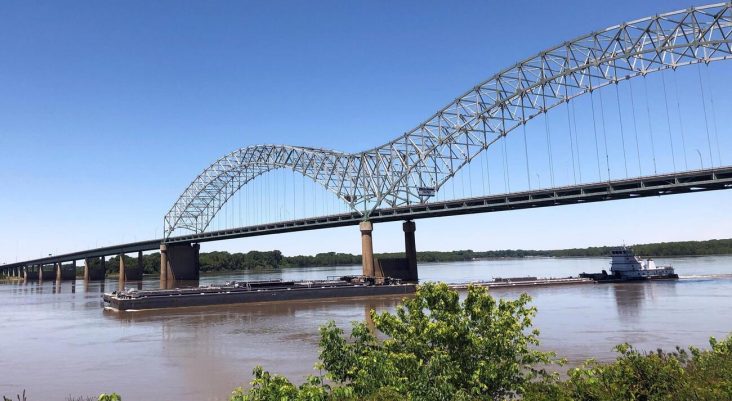Historic low water levels on Mississippi River stymie commercial barge traffic in Arkansas
by October 18, 2023 4:19 pm 1,604 views

Commercial barge traffic on the Arkansas River has been shuttered due to the Mississippi River’s historic low water levels, Port of Little Rock Executive Director Bryan Day told Talk Business & Politics. Water levels at Montgomery Point Lock and Dam, are too low for commercial traffic, he said.
Dredging efforts could have the traffic flowing again in 7-10 days, but there is no guarantee that will happen, Day said.
If a commercial barge can get onto the Arkansas River or any water in its tributary system, it can move all the way to Tulsa, Okla., with no issues, he said. Water levels in the Arkansas River tributary system, named the McClellan-Kerr Arkansas River Navigation System, are passable.
“The barges can no longer push through … it hasn’t been raining in the Midwest,” Day said. “The low water on the Mississippi River is becoming more and more of a challenge.”
The U.S. Army Corps of Engineers has deployed a dredge boat and a sonar boat near the dam which sits at the confluence of the Mississippi River and the White River in Desha County. The White River is part of the Arkansas River system.
A second dredge boat is slated to arrive within a week, Day said. It’s difficult to calculate or gauge the economic impacts of the river shutdown, Day said.
In 2019, historic floods shut down the navigation system for six weeks, and it was estimated at its peak, it was having a $23 million per day impact to the state’s gross domestic product, or GDP, according to the Encyclopedia of Arkansas.
This shutdown is different, Day said. Recreational activities on the river system haven’t been stopped, and many industries that use the river system to move raw materials typically have a month or more of supplies saved in case of an emergency like this, he said.
But the daily impacts will only grow as the river level remains low, he added. Some industries such as agriculture need river access now during the harvest and it will have an impact on the state’s largest economic sector.
There are numerous reports in the media and on social media about truckloads of soybeans and other staple crops being dumped near the Mississippi River. For many farmers it’s cheaper to dump the crop on the ground as opposed to spending the fuel to move it back to the farm.
The Mississippi River at Memphis was at minus 11.5 feet on Sunday, the lowest level ever recorded at that point in the river, according to the U.S. Army Corps of Engineers. If confirmed, it will beat the record of minus 10.81 feet set last year.
Water levels along the river are so low that in Louisiana, where the river drains into the ocean, salt water is backfilling the low river and endangering water supplies.
The U.S. Drought monitor reported that nearly every county along the river is in some level of drought and there are pockets of extreme drought throughout its entire tributary system stretching into the upper Midwest and the Great Plains.
Day said these destructive weather patterns, fueled by global climate change, are not expected to change anytime soon. He said that he’s seen information that drought-like conditions are expected to be pervasive in the Midwest and South during the next decade and it’s going to have significant economic impacts.
Weather patterns in the region might slightly improve during the next two weeks, according to the National Weather Service. In Arkansas, it’s predicted that precipitation will be higher than normal during the period and that will be the case for states on adjacent sides of the river and its tributaries. But the prediction is only a 50-50 possibility, meaning there could still be many areas that remain in drought conditions.
Despite the numerous challenges officials are battling, Day said he remains optimistic. The Corps has done an excellent job of maintaining the 17 locks and dams in the Arkansas River system, and Day said he knows they will do whatever needs to be done to get traffic flowing at the Montgomery Lock and Dam again.
“Hopefully, this shutdown is short, and we can get traffic moving again. Hopefully, we will get some rain,” he said.
